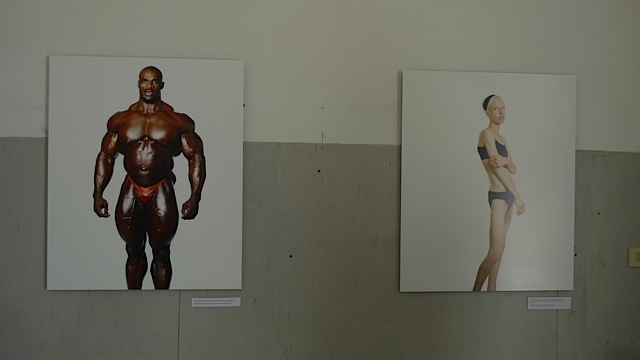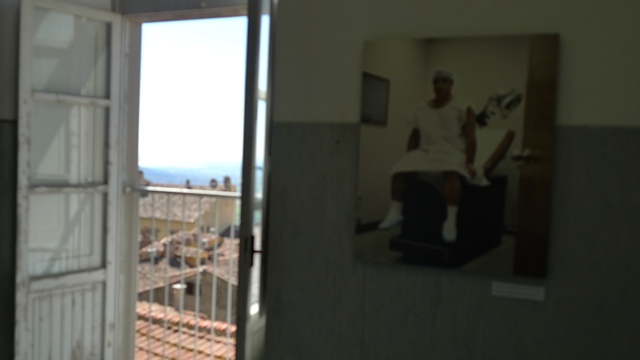LETTER FROM CORTONA, ITALY
By Kevin Ott
Cortona is a walled Etruscan hill town 1 ½ hours southeast of Florence by auto, mostly via the white-knuckling auto-strada. A bit less of a tourist destination than some other Tuscan towns—smaller than Siena, maybe less charming and trampled than San Gimignano—its nearly carless, cobbled steep and narrow streets meander the hillside. Our home for two days, a picture perfect villa rented by old friends just outside of town, overlooking the hills, groves of olive trees and grape vines.
I expected the camaraderie of old college friends and our wives, too much drink, beautiful vistas, dinners on a postcard perfect veranda and afternoons by the pool. We got that. But, I did not expect one of the finest exhibitions of contemporary photography I have seen. “Cortona on the Move: fotgrafia in viaggio” takes place in six venues scattered around the village, with the work of 13 photographers. Think Foto Focus, the Cincinnati event, but cohesively curated to a singular, though broad, theme and taking place during a defined period. Then picture the art hanging on walls of a centuries’ old fortress, an ancient former hospital or a church, the work taking on new meaning and beauty on seven hundred year old stone walls.
“On the Move”, the title and, in essence, the theme or thread that ties together the various exhibits—movement and its many manifestations. Antonio Carloni, Festival Director, describes the work as “photography in travel, as a dream, as magic…the images open the doors of time, past and present merge. The logical thread that connects all the exhibitions shares the travel and drifts to various experiences.”
Our first day, we wound our way up the steep alleys and paths to the top of Cortona and the fortress, where we took in Jergen Toirkens “Nomad”. Since 1999, Toirkens, of the Netherlands, has documented the last living nomads of the Northern Hemisphere. The photos depict the brief, harsh lives of various Mongolians, Alaska’s Inupiat, Russian Sami and Nanets. Climate change, globalization and oil exploration have disrupted the migratory patterns of the animals these Nomads often follow and use to survive. Their population is in steep decline. The photos of these weathered people in their often brutally cold and barren surroundings are soulful and full of loneliness. Survival is their goal, comfort an unknown.
Also in the Fortress, the excellent American photographer, Joel Meyerowitz’ “Taking My Time”. Photos from the mid-sixties up to his iconic picture of The World Trade Center site days after the 9/11 attack, show Meyerowitz’ nearly peerless ability to capture everyday scenes of movement that evoke emotions of nostalgia and wonder, or in the case of the 9/11 photos, awe and loss. These, in particular, are somehow beautiful in their depiction of horror and loss, and paired with the work from the ‘60s and ‘70s convey the overall feeling of the mystery of the movement of time. A gorgeous show.
At the old shuttered Cortona hospital, part way back down some steep steps and paths, 4 shows are scattered around the old operating rooms, patient rooms and hallways. The vibe is all illness, old medicine, disinfectant and death. But, the first show we see here is about beauty, or perceived beauty, and transformation. Zed Nelson, the much awarded and shown London based photographer has, over 5 years and through 18 countries, assembled a body of work that, as Artistic Director Arianna Rinaldo says “reflects on the cultural and commercial forces that drive a global obsession with youth and beauty. The project explores how a new form of globalization is taking place, where an increasingly Western beauty ideal is being exported around the world like a crude universal brand.” The opening image of a spookily perfect 9 year old Texas pageant winner sets the stage for succeeding images: a 19 year old Iranian woman’s rhinoplasty “nose job” operation; a young man’s complete chest waxing in New York; a tub of fat removed during a tummy tuck operation in Maylasia, and, maybe most striking, side-by-side images of an absurdly muscular body builder and a skeletal anorexic young woman. The curatorial theme of movement now refers to the transition of our natural selves to the idealized version of ourselves. It’s an arresting and sad show, but beautifully photographed and installed.
Another favorite was “Trilogy” by Christian Lutz, the Geneva documentary photographer. His is a three-fold investigation of power in the political, economic and religious worlds. “Protokall” follows a ministerial delegation with photos of tarmac meeting beside private jets and hotel confabs. “Tropical Gift” captures behind the scenes oil trading in Nigeria. The third part of the trilogy, “In Jesus’ Name” captures a Zurich based evangelical community and the power it has over its followers. Taken as a whole “Trilogy” rides the hidden currents of the cult of power in politics, energy and religion. The photos are intimate, behind-the-scenes and leave you feeling a bit adrift in someone else’s game. Once again, an affecting show.
There were several other top notch shows, all worth seeing. As a whole, I think the cohesive theme, however broad, was well executed and made further exploration more interesting. By not staggering the timing of the shows, but presenting it as a unified series defined the experience coherently.. It might be a model for a more condensed and satisfying Foto Focus in Cincinnati—not necessarily in terms of curatorial oversight, but in the more condensed time frame making for a more unified experience. Certainly the location in a beautiful Tuscan town with all venues very walkable, as well as the food, the scenery and the unlikeliness of stumbling upon this show added to its great allure.
Kevin Ott






